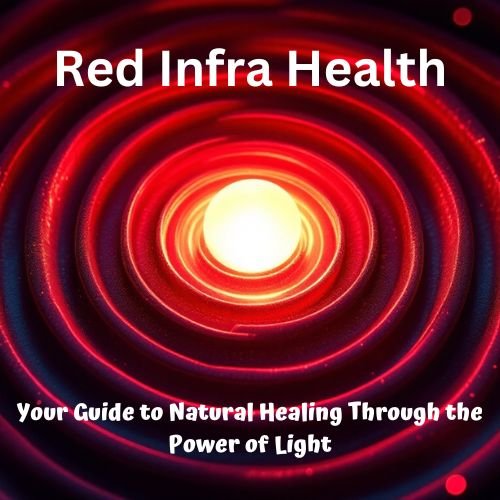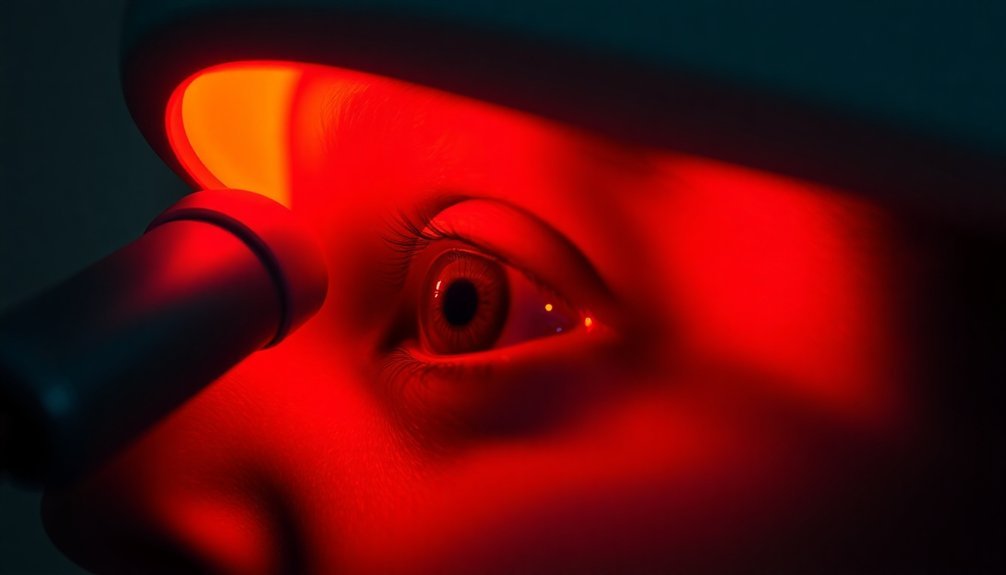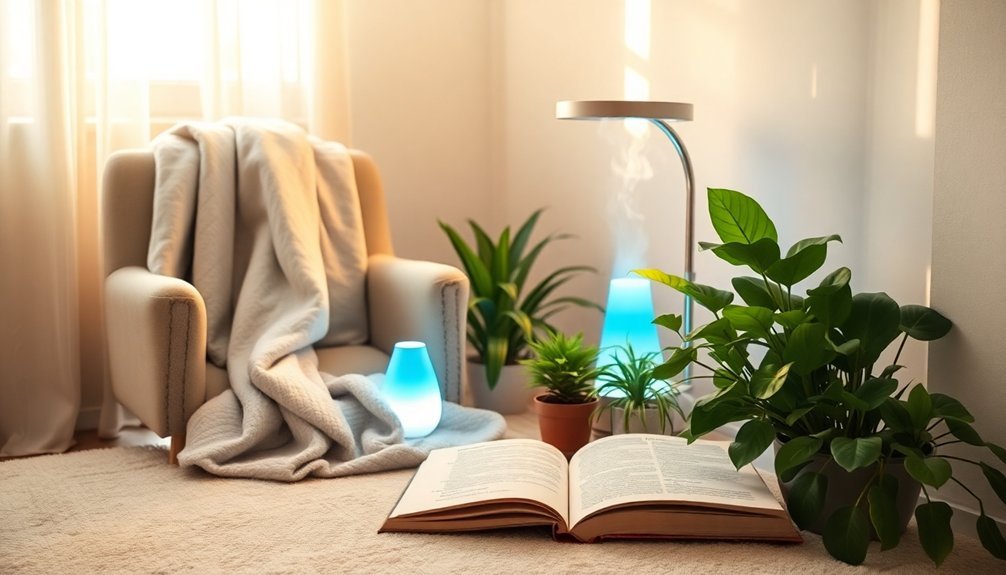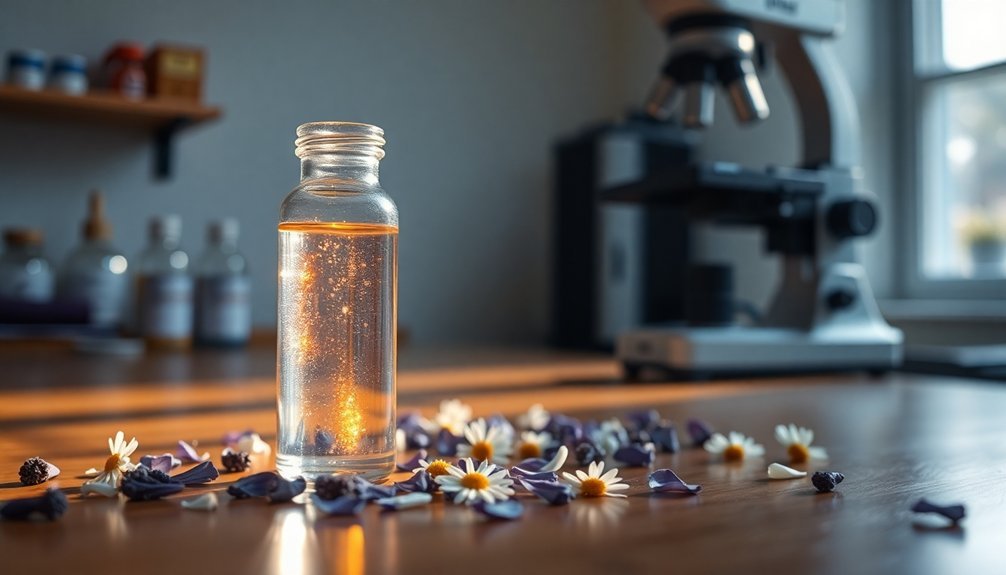You can't safely treat diabetic retinopathy at home with phototherapy or light devices. This serious eye condition requires professional medical care from an ophthalmologist who can provide proven treatments like laser photocoagulation, anti-VEGF injections, or surgery depending on your specific case. Attempting home treatments could delay essential medical care and lead to permanent vision loss. While you can support your eye health through blood sugar control and regular checkups, only a qualified eye doctor can properly diagnose and treat retinopathy. Let's explore the professional treatment options that can help protect your vision.
Understanding Retinopathy and Light Therapy

The devastating effects of diabetic retinopathy often begin silently, damaging your retina's blood vessels before you notice any symptoms. When you have diabetes, high blood sugar can block the tiny vessels that nourish your retina, causing them to weaken and leak. Regular eye exams can help detect the condition early before serious damage occurs.
Your eye tries to compensate by growing new blood vessels, but these are fragile and prone to bleeding.
You'll need to understand the two main types of diabetic retinopathy. The early stage, called nonproliferative diabetic retinopathy (NPDR), involves weakening blood vessels that may leak fluid.
If your condition advances to proliferative diabetic retinopathy, damaged vessels close off and new, abnormal ones grow, potentially leading to retinal detachment or glaucoma.
Light therapy, specifically photocoagulation, has emerged as an effective treatment option. Modern approaches use tissue-sparing techniques like micropulse diode laser therapy, which minimizes damage while treating the condition.
These treatments work by creating controlled temperature increases in your retina, triggering beneficial changes without visible damage. The newest laser technologies use precise wavelengths and brief, repetitive pulses to protect your retinal tissue while effectively managing the condition.
Home Phototherapy Device Options
Modern phototherapy devices have opened up exciting possibilities for managing diabetic retinopathy at home. You'll find several device types available, each using specific light wavelengths to target retinal damage.
Multiwavelength devices, like the Valeda Light Delivery System, use multiple light frequencies (590 nm, 660 nm, and 850 nm) and have shown promising results in clinical trials. A typical treatment protocol requires 3-4 week sessions repeated every 4 months for optimal results.
If you're contemplating home phototherapy, you'll encounter options ranging from wearable devices to specialized contact lenses. Near-infrared light-emitting contact lenses have demonstrated safety and effectiveness in reducing retinal vascular problems.
While single-wavelength devices exist, they've shown less effectiveness compared to their multiwavelength counterparts.
When selecting a device, you'll need to evaluate safety features and regulatory approvals. All approved devices maintain controlled light intensity levels to prevent phototoxicity. Clinical studies, including LIGHTSITE I and II, have confirmed both the safety and efficacy of these treatments.
You'll find that modern devices incorporate proper eye protection measures and meet strict regulatory standards. While home devices offer convenience, remember that they're designed to complement, not replace, professional medical care.
Safe Treatment Steps

After considering device options, it's important to understand that true retinopathy treatment requires professional medical care, not home phototherapy. You shouldn't attempt to treat retinopathy at home with phototherapy devices, as these are designed for skin conditions and could seriously damage your eyes.
Instead, you'll need to work with an eye specialist who can provide proper treatments like laser therapy or anti-VEGF injections. Your doctor will develop a personalized treatment plan that may include focal laser treatment to seal leaking blood vessels or panretinal photocoagulation to reduce abnormal vessel growth. Early detection through regular dilated exams is crucial for successful treatment outcomes.
You'll likely receive these treatments in a clinical setting with proper safety measures and monitoring. If you're prescribed anti-VEGF therapy, you'll need to maintain a regular schedule of injections, typically administered monthly. Your doctor will use anesthetic eye drops to guarantee your comfort during the procedure.
During treatment, you may experience temporary blurred vision, and some treatments like PRP could affect your peripheral or night vision. Remember, successful treatment depends on following your doctor's instructions precisely and attending all scheduled appointments.
Don't delay seeking professional care, as retinopathy requires immediate medical attention to prevent vision loss.
Benefits and Expected Results
You'll likely notice initial vision improvements within the first few months of consistent photobiomodulation treatment, with clinical studies showing that 55% of patients gain at least 5 letters on vision charts after 13 months.
Your quality of life can improve through better visual acuity, reduced eye strain, and enhanced ability to perform daily tasks like reading or driving.
Treatment outcomes are measurable through regular eye exams that track changes in visual function, retinal health markers, and electroretinography results showing improved cellular responses to light stimulation. Research has shown that treated eyes maintain stability with no drusen increase, which is a positive indicator for managing AMD progression.
Vision Improvement Timeline
Understanding your expected timeline for vision improvement can help set realistic expectations for recovery. If you're dealing with Central Serous Retinopathy (CSR), you'll typically see improvement within 3 to 6 months without treatment. However, if your condition persists beyond 6 months, you'll need to think about treatment to prevent potential retinal damage.
For chronic CSR cases, Photodynamic Therapy (PDT) offers promising results. You can expect to see stable or improved vision as early as 6 weeks after PDT treatment. Half-dose verteporfin PDT has shown particularly good outcomes, often resulting in complete resolution of subretinal fluid with minimal side effects.
If you're using photobiomodulation for dry AMD with the Valeda Light Delivery System, you may see significant improvements within 13 months. About 55% of treated eyes show improvement of at least 5 letters on the eye chart during this period. You'll also benefit from slower disease progression and reduced drusen formation compared to untreated eyes.
Recovery timelines vary based on your specific condition and treatment method, but consistent monitoring and following your prescribed treatment schedule will optimize your results.
Quality of Life Gains
Light-based retinopathy treatments offer substantial improvements to daily living that extend far beyond vision correction alone. You'll experience minimal disruption to your lifestyle since treatments can be integrated into your nightly routine through comfortable contact lenses that work while you sleep. Unlike traditional interventions requiring frequent hospital visits, you can manage your condition from home with reduced side effects and greater convenience.
| Life Aspect | Before Treatment | After Treatment |
|---|---|---|
| Daily Activities | Frequent medical visits | Home-based care |
| Treatment Impact | Invasive procedures | Non-invasive therapy |
| Comfort Level | Discomfort from injections | Comfortable contact lenses |
| Long-term Results | Tissue damage risk | Better tissue preservation |
You'll benefit from the latest advances in phototherapy that protect your retinal health while maintaining your regular sleep patterns. The treatment's non-invasive nature means you won't face the complications often associated with traditional laser procedures or injections. By combining ortho-K vision correction with phototherapy, you'll enjoy clear daytime vision while simultaneously preventing retinopathy progression. This dual benefit markedly improves treatment compliance and leads to better long-term outcomes, helping you maintain your independence and quality of life.
Measurable Treatment Outcomes
Clinical studies demonstrate remarkable vision preservation rates with modern retinopathy treatments. Research shows that early intervention with panretinal photocoagulation (PRP) can reduce your risk of severe vision loss from 26% to just 11% within two years. After four years, only 20% of treated eyes experience severe vision loss compared to 44% in untreated cases.
You'll find that newer treatment options offer significant advantages. Subthreshold micropulse laser therapy delivers similar benefits to traditional laser treatments but without visible damage to your retinal pigment epithelium.
If you're concerned about discomfort, short-pulse duration treatments (20 ms) cause less pain than conventional methods while maintaining effectiveness.
The treatments work by triggering beneficial biochemical changes in your retina through controlled photothermal interactions. When laser light is absorbed by melanin in your eye's tissues, it creates therapeutic effects that reduce neovascular disease by decreasing relative ischemia and limiting the production of harmful angiogenic factors.
While scientists continue studying the exact mechanisms, clinical evidence confirms these treatments' effectiveness in preserving your vision when administered properly and promptly.
Essential Safety Precautions

Before starting any home retinopathy treatment, you'll need proper UV-blocking goggles specifically matched to your phototherapy device, as standard sunglasses won't provide adequate protection against harmful radiation.
You must maintain regular supervision with your eye doctor throughout the treatment process to monitor your condition and adjust protocols as needed.
Your phototherapy device should meet FDA-approved standards and come with clear manufacturer guidelines for safe operation, including specific requirements for protective eyewear and usage duration.
Proper Eye Protection Equipment
When undergoing retinopathy treatment at home, proper eye protection serves as your first line of defense against potential damage from therapeutic light exposure. You'll need to select high-quality protective equipment that effectively blocks harmful rays while maintaining comfort during treatment sessions.
Black cotton fabric, especially when combined with foam, provides superior protection during intensive phototherapy. You can also opt for specialized devices like Eyemax 2 or WeeSpecs, which are specifically designed for maximum coverage and comfort.
These one-piece wraparound designs prevent unwanted movement and maintain a secure fit throughout the treatment.
Remember to remove eye protection every 4-6 hours for essential eye care and during feeding times. This helps prevent pressure-related irritation and allows you to monitor for any signs of discomfort.
When selecting your eye protection, prioritize latex-free materials that won't irritate sensitive skin.
For enhanced safety, consider using light shield curtains alongside your primary eye protection to prevent any light leakage. Don't compromise on quality – proper eye protection is vital to prevent retinal damage during phototherapy.
Always make sure your chosen equipment fits properly and maintains its position throughout treatment sessions.
Medical Supervision Requirements
The proper handling of retinopathy requires consistent medical oversight, regardless of any home-based treatments you might pursue. It's vital to understand that diabetic retinopathy isn't a condition you can treat independently at home with phototherapy, as this approach isn't a standard or recommended practice for this eye condition.
Your treatment journey should involve regular professional examinations, especially if you have risk factors like uncontrolled blood sugar or are pregnant with diabetes. An ophthalmologist needs to monitor your condition closely through thorough eye examinations and specialized imaging techniques like fundus photography.
You'll need frequent ophthalmological assessments to detect and address complications early, particularly if you have diabetic macular edema or proliferative diabetic retinopathy.
Your treatment plan must be adjusted based on professional interpretations of diagnostic images and disease progression.
You should seek immediate professional care if you notice any changes in your vision, as home-based treatments can't replace proper medical intervention.
Remember that while some conditions can be treated with home phototherapy, diabetic retinopathy requires specialized medical procedures like laser photocoagulation that must be performed in a clinical setting under professional supervision.
Device Compliance Standards
Protecting your eyes during any light-based therapy requires strict adherence to specific device safety standards. You'll need to verify that your device meets ICNIRP guidelines and includes proper safety features like automatic shut-offs and timers.
It's vital to match your protective eyewear to the specific light source you're using, as different wavelengths pose varying risks of retinal damage.
Before starting treatment, make sure your device provides controlled light exposure and includes clear documentation on safety compliance. You'll need to inspect your equipment regularly and maintain it according to the manufacturer's guidelines.
Don't use the device if you notice any damage or malfunction, as this could compromise your safety.
For home-based treatments, you must use devices that direct light below the head and don't require eye masking. You'll need to follow the American Academy of Pediatrics guidelines and maintain regular physician supervision.
Keep detailed records of your treatment sessions and monitor your condition daily. If you're unsure about the device's quality or your ability to use it safely, don't proceed with home treatment.
Remember that proper post-treatment protection is essential for certain types of phototherapy.
Proper Treatment Timing and Duration
Professional medical treatment timing is essential for managing diabetic retinopathy effectively. You'll need to understand that laser therapy isn't a home treatment and requires professional medical settings.
If you've been diagnosed with proliferative diabetic retinopathy (PDR), don't delay seeking treatment, as prompt intervention substantially reduces your risk of severe vision loss.
For diabetic macular edema (DME), your doctor will likely start with anti-VEGF agents before considering laser treatment. When laser therapy is needed, you should expect the treatment effects to emerge over 2-3 months, and you may need repeat sessions.
Follow-up appointments are vital to monitor your progress and determine if additional treatments are necessary.
Treatment sessions may be divided into 2-4 visits to minimize discomfort and reduce post-laser complications.
Your glycemic control should be maintained at an HbA1C of 7% or less for effective treatment outcomes.
If you're receiving panretinal photocoagulation (PRP), your doctor will schedule multiple sessions to guarantee complete coverage while minimizing side effects. Remember that the effects of laser treatment can last up to 18 weeks, but you might need additional sessions based on your response to the treatment.
Frequently Asked Questions
Can I Combine Phototherapy With Other Retinal Treatments Like Injections?
You shouldn't combine phototherapy with other treatments on your own. Only medical professionals can safely administer combination therapies, which require precise protocols, proper monitoring, and careful timing between different treatments.
How Long Should I Wait After Cataract Surgery Before Starting Phototherapy?
You should wait at least 1-4 days after cataract surgery before starting phototherapy. However, consult your eye doctor first, as they'll determine the best timing based on your healing progress and specific needs.
Will Insurance Cover Home Phototherapy Devices for Retinal Treatment?
Insurance typically won't cover home phototherapy devices for retinal conditions. They're primarily covered for skin conditions like psoriasis. You'll need to consult your insurance provider and ophthalmologist for specific coverage details.
Can Children With Juvenile Retinal Conditions Use Phototherapy Devices?
You shouldn't use phototherapy devices on children at home without medical supervision. While these treatments show promise for juvenile retinal conditions, they must be administered by healthcare professionals in clinical settings.
Does Eye Color Affect the Effectiveness of Phototherapy Treatment?
You don't need to worry about your eye color when getting phototherapy treatment. Research hasn't found any direct connection between iris color and treatment effectiveness, as phototherapy primarily affects your retina, not iris pigmentation.
In Summary
While you can safely use phototherapy devices at home to help manage retinopathy symptoms, you'll need to follow proper protocols and safety guidelines. Don't skip consulting your eye doctor before starting any home treatment. When used correctly, light therapy can complement your existing treatments, but it shouldn't replace professional medical care. Remember to track your progress and report any concerns to your healthcare provider.





Leave a Reply